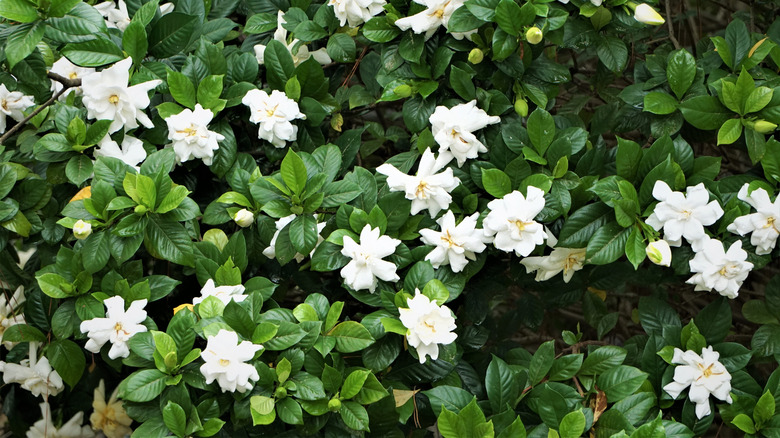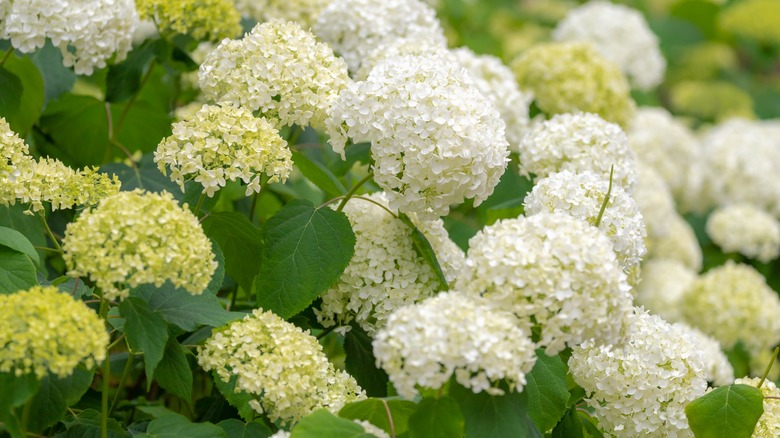While hydrangeas and their large, colorful blooms are certainly eye-catching enough on their own, they can make even more of a statement in your garden when planted next to smaller flower varieties that complement their size and form. Flowering plants like the gardenia with abundant rich greenery make for a visually exciting display when planted next to blooming hydrangeas, which don’t offer the same amount of evergreen color.
Unlike hydrangea, known for its fluffy, large blooms, gardenia is more understated in its beauty, given the relatively small size of its flowers. This juxtaposition in size and shape looks very polished side by side, and frames and lawn or walkway in a way that is hard to match. If you live in an area with a mild to warm climate year-round where gardenias are hardy, planting them next to your hydrangea is an excellent way to add beauty to your garden and the landscape of your home. Otherwise, you can plant rhododendrons or azalea for a similar contrasting effect.
Despite their differences in the size of their leaves and floral displays, they share the same soil preferences, which makes them good candidates for planting near one another. What’s more, both hydrangea and gardenia are known pollinator plants, making them good side-by-side plants in pollinator gardens — and what’s good for the bees is good for us!
The contrasting shapes and sizes pair well in a landscape setting

The stark differences between the size of the flowers of each plant are what visually makes them good candidates for planting next to each other. Because the large, fluffy flowers of a hydrangea dominate the plant with color while in full bloom, the small, understated flowers on a gardenia bush are the perfect way to balance it out and add an additional layer of beauty in a way that doesn’t compete or overwhelm. The dark green leaves of gardenias help break up some of the colors when planted next to hydrangeas, which keeps the overall landscape from looking busy.
“I love the cloud-like blooms of a white hydrangea paired with the fragrant white blossoms of gardenia,” says Kip McConnell, director of Southern Living Plant Collection (per Homes & Gardens). “The large, sculpted leaves of hydrangea meld seamlessly with the deep green foliage of gardenia, creating the perfect backdrop upon which the plants’ white blossoms pop.”
Gardenia and hydrangea require the same soil

In addition to looking beautiful when planted next to each other, hydrangea and gardenia can also be planted in the same soil, adding to their companion plant potential. Both flowering plants need a fertile, well-draining soil that stays consistently moist to grow and bloom to their full potential, so it makes practical sense to plant them side by side in the same soil.
Your hydrangea and gardenia plants will also both thrive in soil that is of a similar pH level, with each preferring a more acidic one. While hydrangea plants can tolerate soil with a slightly more neutral pH, they tend to thrive better in more acidic soil with a pH level of 5–6, which also happens to be the minimum level of acidity that gardenia requires. Keep in mind that the pH level of the soil will affect the color of your hydrangeas.
Growing your hydrangeas next to your gardenias in acidic soil will likely result in blue flowers. If you prefer blooms in the white or pink family, you can try to grow your hydrangea in a part of your garden away from your gardenia and other plants that need acidic soil. You can also try adding a few tablespoons of lime juice near the base of your hydrangea plant every six months, which can help change the color palette to pink over the course of the next year.



